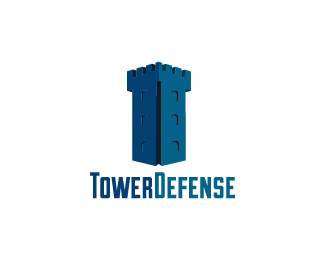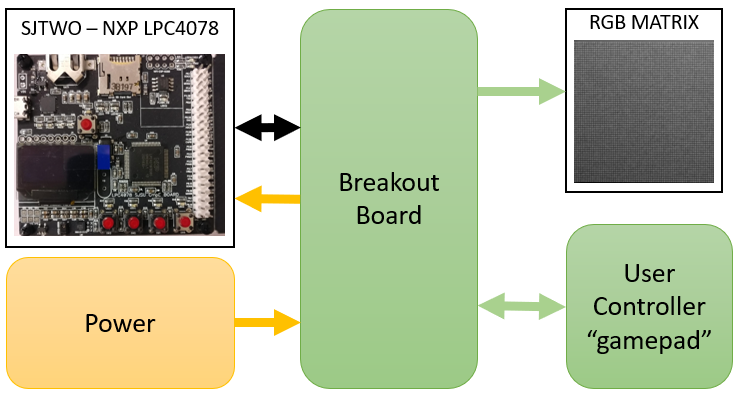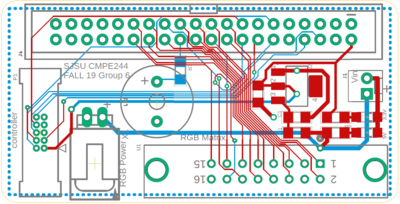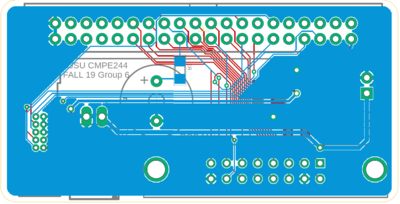Difference between revisions of "F19: Tower Defense in Space"
Proj user10 (talk | contribs) (→Breakout Board Design) |
Proj user10 (talk | contribs) m (→Breakout Board Design) |
||
| Line 288: | Line 288: | ||
'''4.''' Input power supply (5V) <br> | '''4.''' Input power supply (5V) <br> | ||
'''5.''' The SJTWO embedded system <br> | '''5.''' The SJTWO embedded system <br> | ||
| + | |||
| + | {| | ||
| + | |[[File:Breakout_Rev0.1.pdf|1000px|thumb|left|Breakout Board Schematic]] | ||
| + | |} | ||
| + | |||
Revision as of 01:44, 13 December 2019
Contents
Grading Criteria
- How well is Software & Hardware Design described?
- How well can this report be used to reproduce this project?
- Code Quality
- Overall Report Quality:
- Software Block Diagrams
- Hardware Block Diagrams
- Schematic Quality
- Quality of technical challenges and solutions adopted.
Project Title
Tower Defense ... In Space
ABSTRACT
My abstract goes here.
INTRODUCTION AND OBJECTIVES
|
TEAM MEMBERS & RESPONSIBILITIES | ||||
|---|---|---|---|---|
|
Team Members |
Administrative Roles |
Technical Roles | ||
|
Team Lead |
| ||
|
Git Repo Manager |
| ||
|
Wiki Report Manager |
| ||
|
Bill of Materials Manager |
| ||
SCHEDULE
|
TEAM MEETING DATES & DELIVERABLES | ||||
|---|---|---|---|---|
|
Week# |
Date Assigned |
Deliverables |
Status | |
| 1 | 10/15/19 |
|
| |
| 2 | 10/22/19 |
|
| |
| 3 | 10/29/19 |
|
| |
| 4 | 11/5/19 |
Kelvin
|
| |
| 5 | 11/12/19 |
Kelvin
Polin
Ryan
Zach
|
| |
| 6 | 11/19/19 |
Kelvin
Polin
Ryan
Zach
|
| |
| 7 | 11/26/19 |
Kelvin
Polin
Ryan
Zach
|
| |
| 8 | 12/3/19 |
|
| |
| 9 | 12/10/19 |
|
| |
BILL OF MATERIALS (GENERAL PARTS)
|
MAJOR COMPONENTS | ||||
|---|---|---|---|---|
|
PART NAME |
PART MODEL & SOURCE |
QUANTITY |
COST PER UNIT (USD) | |
|
|
| ||
HARDWARE INTEGRATION
Hardware Design Overview
At a high level hardware integration requirements fell into two categories:
1. Reduce risk of unreliable cable connections and eliminate possibility of damage to components through unexpected disconnections, power surges, etc.
2. Provide a more fluid physical interface for the user to interact with the game via hardware
To accomplish these goals, two boards were designed: a breakout board and a gamepad controller. The breakout board serves as a connection hub between all system hardware components; power, the RGB matrix, the SJTWO board, etc. while the joystick provides a cleaner package to present the user with the games inputs. The diagram below shows the relationship between the main subsystems:
Breakout Board Design
The breakout board design requirement was to interface all external hardware components with the embedded system (SJTWO). The hardware connections are:
1. The 64x64 RGB Matrix
2. Output power to the RGB Matrix
3. User game controller (see next section)
4. Input power supply (5V)
5. The SJTWO embedded system
| File:Breakout Rev0.1.pdf |
Design
- Balancing priorities between HW design and getting a working prototype
Assembly
- Wireless antenna connector on master board not accounted for in footprint, it may have to be removed to avoid interference with one connector.
Bill Of Materials
|
HARDWARE INTEGRATION PCB | ||||
|---|---|---|---|---|
|
PART NAME |
PART MODEL |
QUANTITY |
COST PER UNIT (USD) | |
TEST
In order
Hardware Design
During
We used
CONCLUSION
This pr



